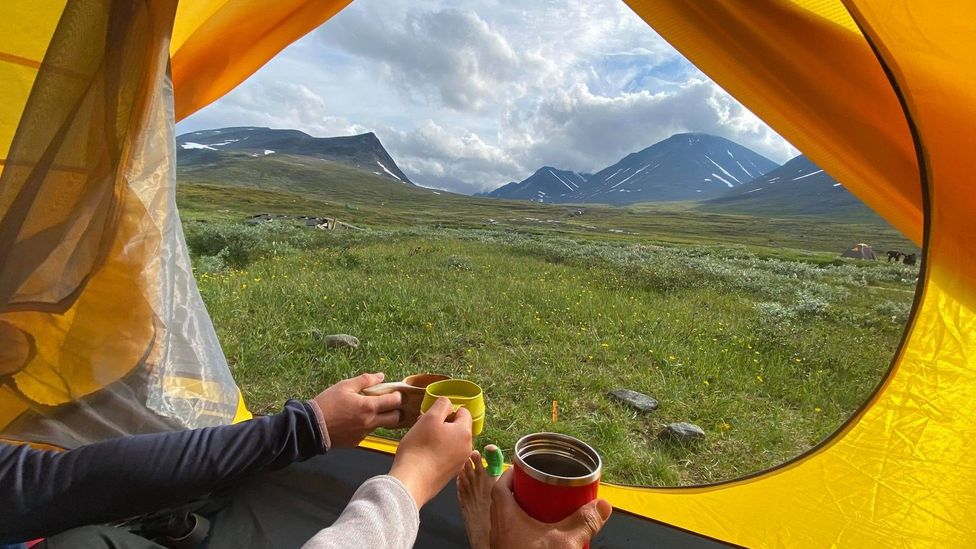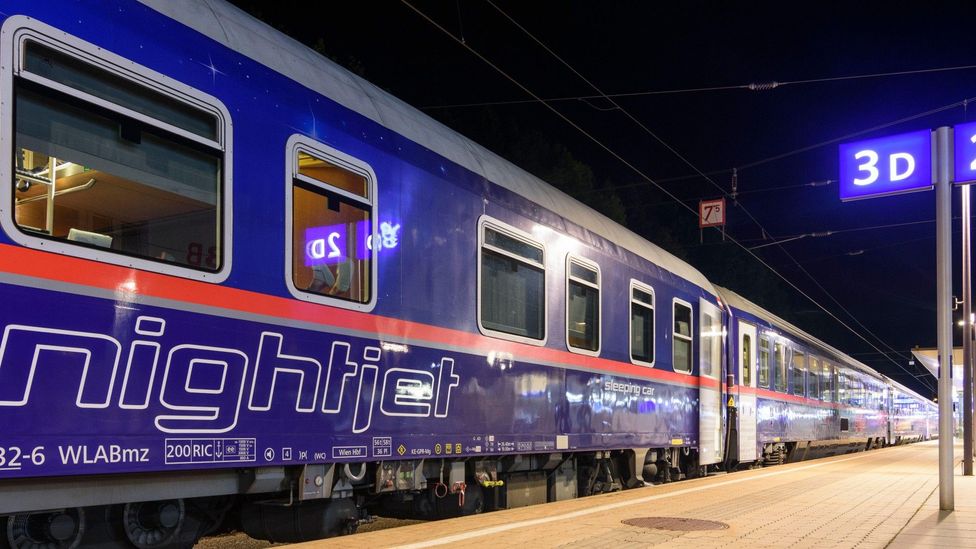Are Europe’s night trains back in fashion?
Sleeper trains were making a slow comeback in Europe before the pandemic, but will Covid-19 help or hinder a renaissance of long-distance rail travel?
Snaking along a rocky coastline towards the wild mountains of Lapland, the 19-hour night train from Stockholm to the village of Abisko was fully booked for much of this summer. Home to the global flight-shaming (flygskam) movement and its star climate campaigner Greta Thunberg, Sweden was already a champion for long-distance train holidays prior to the coronavirus pandemic. In 2019, rail travel jumped by 11% on SJ, its largest railway network. And here, during Covid-19, the sleeper-train trend has remained relatively strong domestically, despite most Swedes still avoiding international travel.
“Night train sales were almost on a par with last summer,” says Stephen Ray, a spokesperson for SJ, a state-owned company. Although Swedish rail passenger numbers were still down overall by around 60% in July and August, he says much of this was due to a drop in business and commuter travellers as well as the company keeping a third of seats empty to enable social distancing. By contrast, domestic air travel fell by a much more dramatic 80%, while global travel to and from Swedish airports dropped even further.
“I don’t think many people wanted to fly, because there weren’t too many places to choose between, so they were staying [in Sweden] and staying close to nature,” says Ray. But he believes the popularity of long-distance trains is, to a great extent “also because we’ve seen over the last few years the climate issue has really started to affect people’s decisions on how they want to travel and be more sustainable”.

Night trains to Abisko in Lapland have proved very popular this summer
Sweden’s government responded to the public mood in 2019 with a promise of a 300m kronor ($32.8m, £26m) investment in train travel, including sleeper services to other parts of Europe. Global train companies are now competing to run night routes from Stockholm to Hamburg and Malmö to Brussels from 2022. Meanwhile, private Swedish operator Snälltåget is planning to offer a new service to and from the Austrian Alps from February 2021, and to revive its services between Malmö and Berlin.
But Sweden is not the only European nation that’s been expanding its long-distance rail offerings. Over the past couple of years, numerous countries including the UK to Austria have begun introducing or revamping sleeper routes that could potentially make rail travel a more efficient and attractive option for the tourist market in the longer term. The shift has captured the attention of many, with travel bloggers, transport planning experts and journalists suggesting the possibility of a European night-train renaissance. Yet there are challenges, both financial, logistical and in terms of the ongoing health risks related to Covid-19.
How close are we really to a significant return to couchette sleeper cabins and late-night suppers in restaurant carriages?
The ‘Greta effect’
European customers were increasingly embracing long-distance rail journeys before the coronavirus outbreak.
Passenger numbers on Austrian train company ÖBB’s night trains doubled from 700,000 to 1.4 million in 2017, after the firm bought up stock from German rail network Deutsche Bahn and took over its routes, becoming the largest sleeper operator in Europe. The company’s customer numbers and profits continued to climb until the start of the pandemic. Swiss operator SBB reported a 25% increase in night train traffic last year, while long-distance travel between Finland and Russia jumped by 20%. This shift contrasted with several decades in which budget airlines dominated the travel industry, and many previously long-running night services were closed down due to high operating costs.
“It’s definitely a European trend. Sweden has been the sort of poster campaign for train travel, but it’s much bigger than that,” says 28-year-old Anton Trollbäck, the Swedish co-founder of All Aboard, an new online platform for booking long-distance train tickets across the continent. “People are more interested in going by environmentally friendly forms of transport and getting closer to nature, and railways just fit very neatly into that gap.”

Anton Trollbäck believes environmental concerns are currently fuelling a rise in interest in long-distance rail travel
The launch of his site, rivalling similar platforms like the UK-based Seat61 and German offering Omio serves to further demonstrate the demand. Meanwhile in a survey for the European Investment Bank released in January, 36% of Europeans said they had already started flying less for holidays in order to fight climate change, with 75% intending to cut down on plane travel in 2020 (a New Year’s resolution that, thanks to the coronavirus, most will have been able to keep).
European governments – encouraged by the shift in the public mood on climate change – are also reinvesting in rail travel in order to help meet EU carbon-cutting targets. In France, home to dozens of overnight rail services in the 1990s, there are currently just two sleeper lines running. But in July, President Emmanuel Macron promised to redevelop the network. He’d previously argued that sleeper services weren’t profitable, but told the nation the move “translates into savings and a reduction of CO2 emissions”. Within the last few months, Germany and Italy have also announced they’re planning to spend billions of euros revitalising rail connections in a bid to make their networks greener and more efficient.
Public and private companies are clearly betting on the train travel trend continuing, too. Austria and Switzerland’s federal railways have clubbed together to expand the number of inter-country overnight services operated through their partnership, with a long-term mission of connecting cities as far apart as Zürich and Barcelona. And Eurostar passengers will be able to travel directly from Amsterdam to London from the end of October.
How safe is train travel during Covid-19?
One key question, however, is what role coronavirus will play in how – and whether – people want to travel over the next few years.
The air quality on trains is actually poorer than on planes, which usually mix in fresh air from outside with high-efficiency filters. But many people “still believe the risk of coronavirus transmission to be lower on trains”, explains Charlene Rohr, a senior research leader who’s been forecasting post Covid-19 travel trends for RAND Europe, an independent research institute. She says some travellers will therefore prioritise train travel due to perceived risks from recirculated air, “because seats on planes are closer together than on trains”, or because they have “concerns about crowding levels in airports”.
That’s been the experience of Jeni Fulton, 38, an executive editor for European art fairs, who has opted to use night trains for business travel between Germany and Switzerland during the pandemic. Although her primary motivation for using trains rather than planes is to limit her carbon footprint, she feels trains are “probably safer with regard to Covid-19” than planes, since she is in contact with fewer people during the journey. “I will definitely consider taking a night train [more in future], especially if I am staying more than a couple of nights,” she says.
But other travellers remain unconvinced. “Sleeping on a night train would not give us the same peace of mind as before,” says Diana Oliveira, a 28-year-old PhD student from Portugal who runs The Nerdy Globetrotters social media accounts with her boyfriend Karn Vohra, from India. “If you want to be protected as much as possible, then a flight seems like a good option, since the time exposure to others would be reduced,” she argues. “Secondly, it is a matter of convenience – wearing a face covering for two hours on a flight or for 10 hours on a train journey.”

Diana Oliveira (pictured here with Karn Vohra) says flying would still be her choice, because it takes less time
Marcus Mayers, a transport analyst at Manchester Metropolitan University, says most European rail companies have introduced coronavirus measures, ranging from compulsory medical masks to reduced seat capacity. But he argues that “no operator is trying to do this in a meaningful way”, and says train companies should consider a more long-term approach – like installing plastic seat dividers or reconfiguring the insides of carriages – to help them compete with airlines. “What the railway industries are doing is undermining this opportunity by not bespoking the product to meet the requirements of customers at the moment,” he says.
Why train travel could stay popular
Despite safety concerns, there are, as major online industry-magazine Railway Technology recently concluded, “some early indications of rail’s success in the post-Covid-19 world”. This year, when long-distance rail pass company Eurail surveyed customers who had travelled in 2018 and 2019, many said taking the train would be their preferred mode of transport for future journeys. In China, where lockdown was lifted months ahead of Europe and transmission rates are close to zero, there has already been a boom in domestic rail travel, which some transport experts believe could be replicated in Europe as people seek holiday spots closer to home.
Researchers from financial-services firm UBS predicted that the pandemic could accelerate the shift from air to rail because it has made consumers and governments even more climate aware. This, they argue, is partly because the world learned “how to cope” without frequent flying and gained a greater appreciation for environments that promote healthier populations. The report’s authors estimate there will be around 800 more high-speed trains in operation in Europe in the next 10 years, while 196 fewer planes will be required globally – reducing global air traffic growth to around 4.6% a year.
At RAND Europe, Charlene Rohr believes rail services may be able to challenge some aviation routes in future, but argues there are several key drivers beyond Covid-19 and the environment. These include improvements in digital connectivity which allow people to be productive on trains and a decline in the comfort of low-cost air travel. “In pre-Covid times airports were more crowded, travelling to airports from our homes and from the airport to our final destination could be costly,” she says. “There seemed to be continual incremental cost increases for additional items such as booking seats, luggage, and increasingly the air journey was becoming more stressful, for example with self-check ins.”

Night trains could potentially end up replacing some aviation routes, Charlene Rohr believes
In addition, for millennial and gen Z consumers, travelling by train fits the generational trend toward seeking out more unique travel opportunities and spending on experiences rather than material possessions. “People have pretty much lost interest in flying to the same old sightseeing destinations that have been featured for 100 years,” argues Anton Trollbäck at All Aboard. “They want to find hidden spots in Europe. And that’s something that train travel is very convenient for.”
It’s a view demonstrated by Danielle Courtenay, 28, a Korean-American copywriter living in Paris, who travelled to Milan during the pandemic. “I find the actual experience of staring out a train window really enjoyable in itself,” she reflects. “For me, there’s a big romance factor involved, too. The ‘slowness’ – if you can call 300km/hour slow – is actually pleasant if you think of it as part of your vacation instead of a barrier to it.”
The long-term challenges
Despite the strong potential for the expansion of train travel, Marcus Mayers at Manchester University argues that future funding is likely to be problematic for rail companies. This is because they typically rely on commuter ticket sales, which have nosedived. “The bread and butter – 60, 70% of the revenue from all railway companies is moving people from their home to the office. So, what you’re seeing is the revenue that supports the fixed asset of the railway being decimated.” While many governments are currently helping to prop up rail lines, and are committed to reaching EU green energy targets, he says there’s still “a black hole in railway finances, which no one knows how to deal with at the moment”.
Would-be travellers are also feeling the Covid-19 pinch. Many have lost their jobs or had their incomes reduced, which raises the question of how many will actually have the money to take holidays. Whether rail firms are able offer more competitive prices than airlines, which are also desperate to recoup losses, may end up playing a crucial role. The European Commission is hoping that a new set of regulations called the Fourth Railway Package, which effectively creates a single market for rail in the EU from 2021, will increase competition from private companies, leading to more train services and lower prices. But many passengers argue that ticket costs would need to be considerably different to make a difference.
“I think planes will continue to have an edge over trains for most people, just because they’re so cheap,” argues Danielle Courtenay in Paris. “It’s going to be a hard sell trying to convince someone who’s only got 20 days of vacation a year to spend two of them on a train, while also paying double or triple the price of a flight.”
Yet despite these challenges, there remains a strong sense in the rail industry that the pandemic will, overall, prove to be a positive catalyst for change. “I think it’s more of an opportunity, even though in the short term it’s a really tough economic situation,” says Stephen Ray, back at SJ’s headquarters in central Stockholm. “It certainly is a game changer, I think, in how we’re going to travel in the future.”
Fuente/ Source: www.bbc.com
Por/ By: Maddy Savage
Foto/ Photo: CNN
PAGINA 100 POPAYAN COLOMBIA


